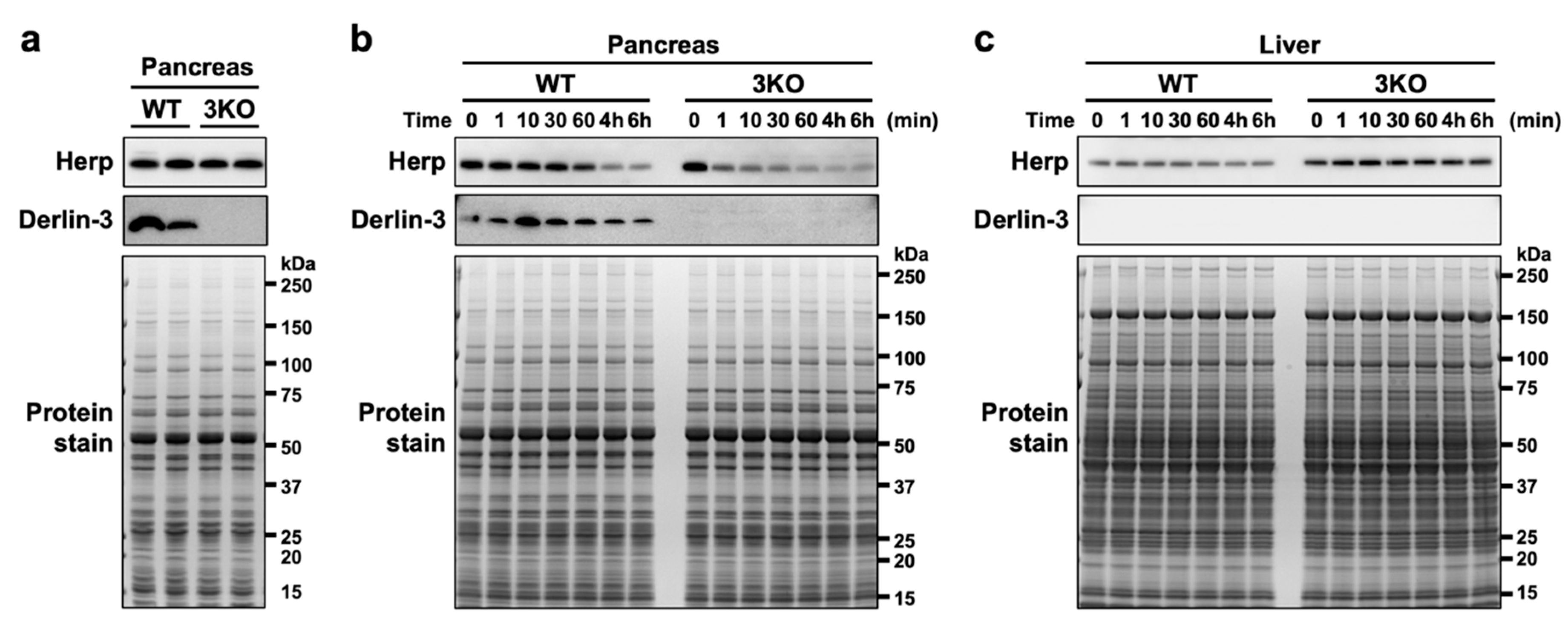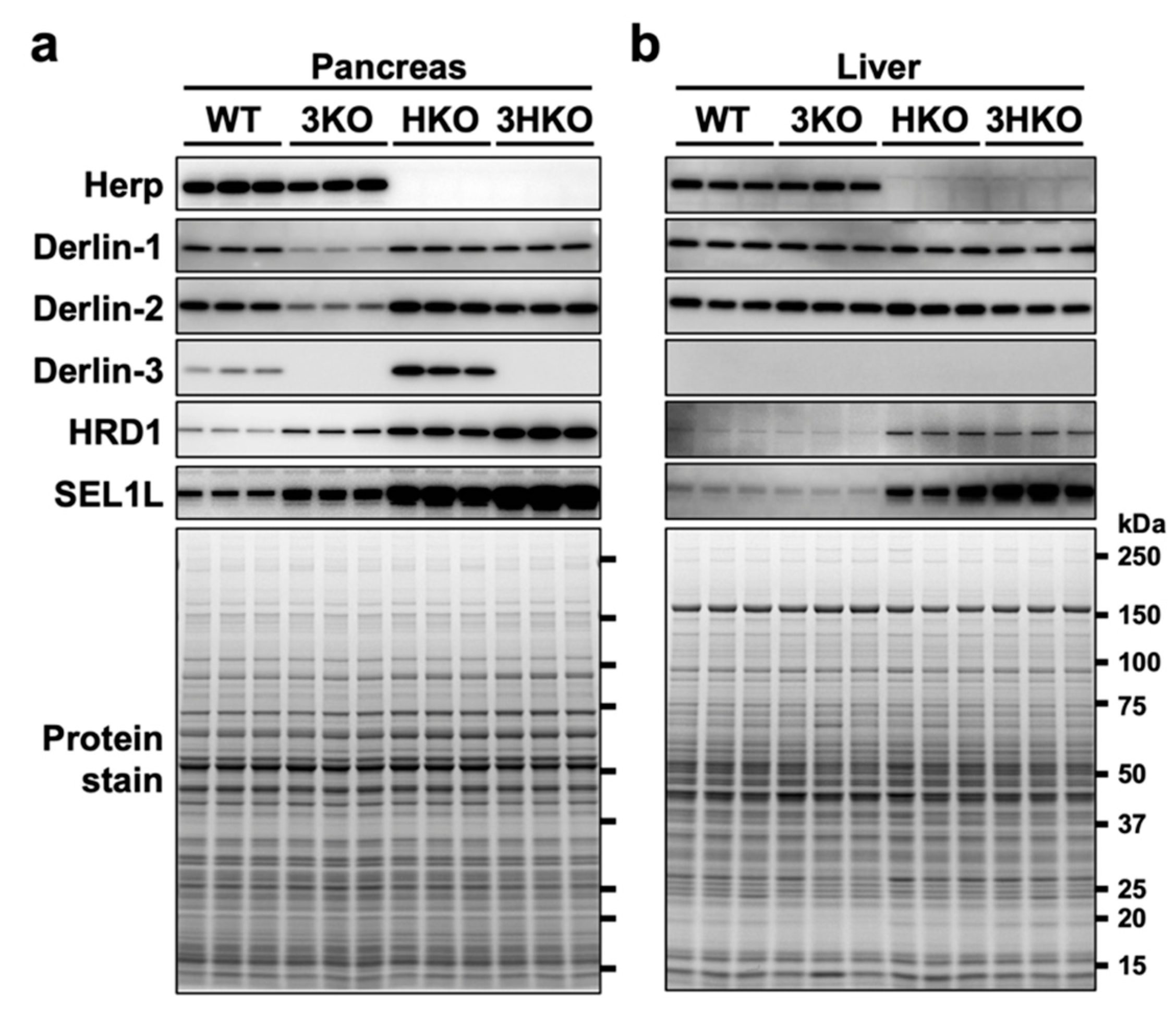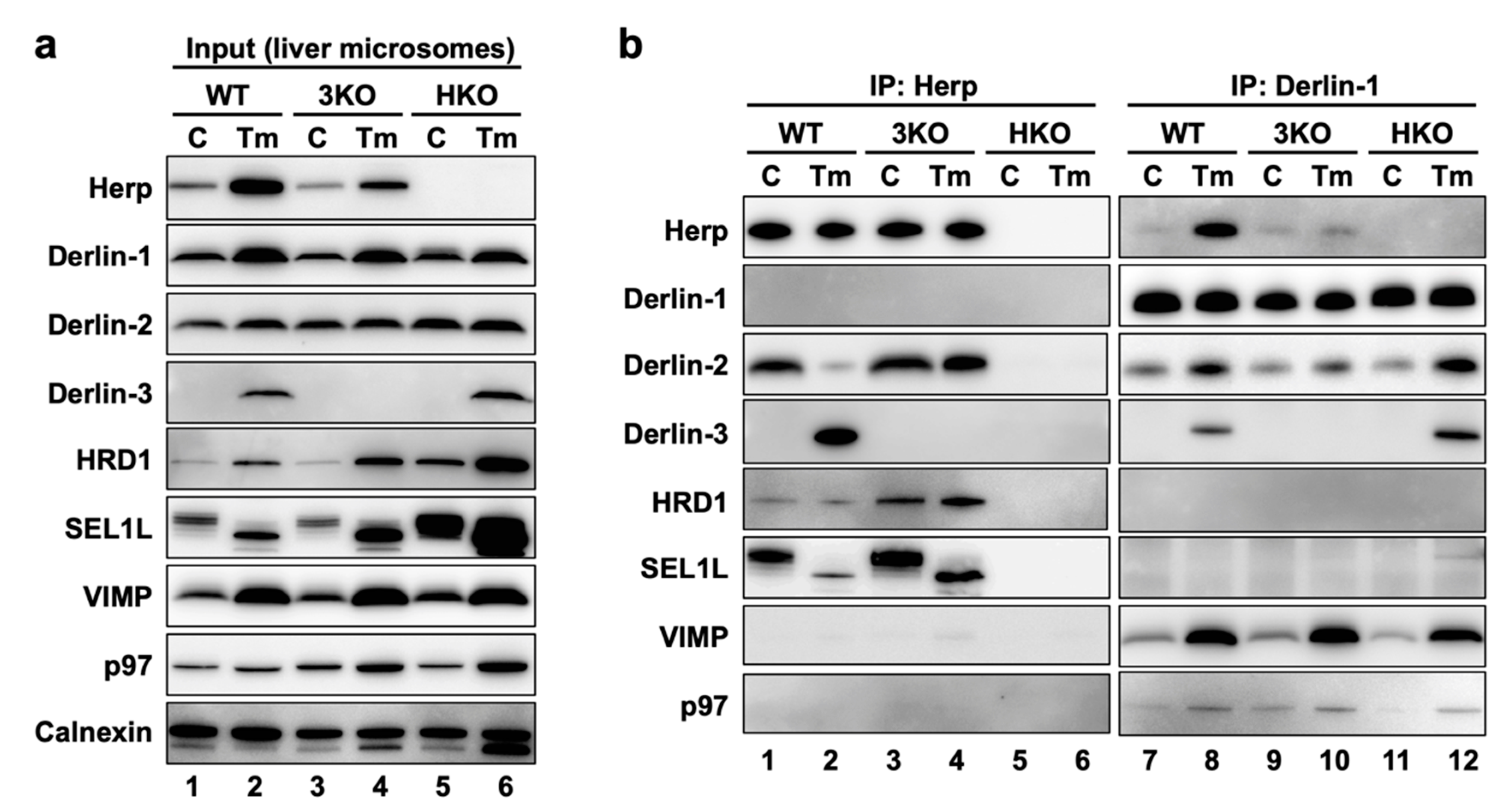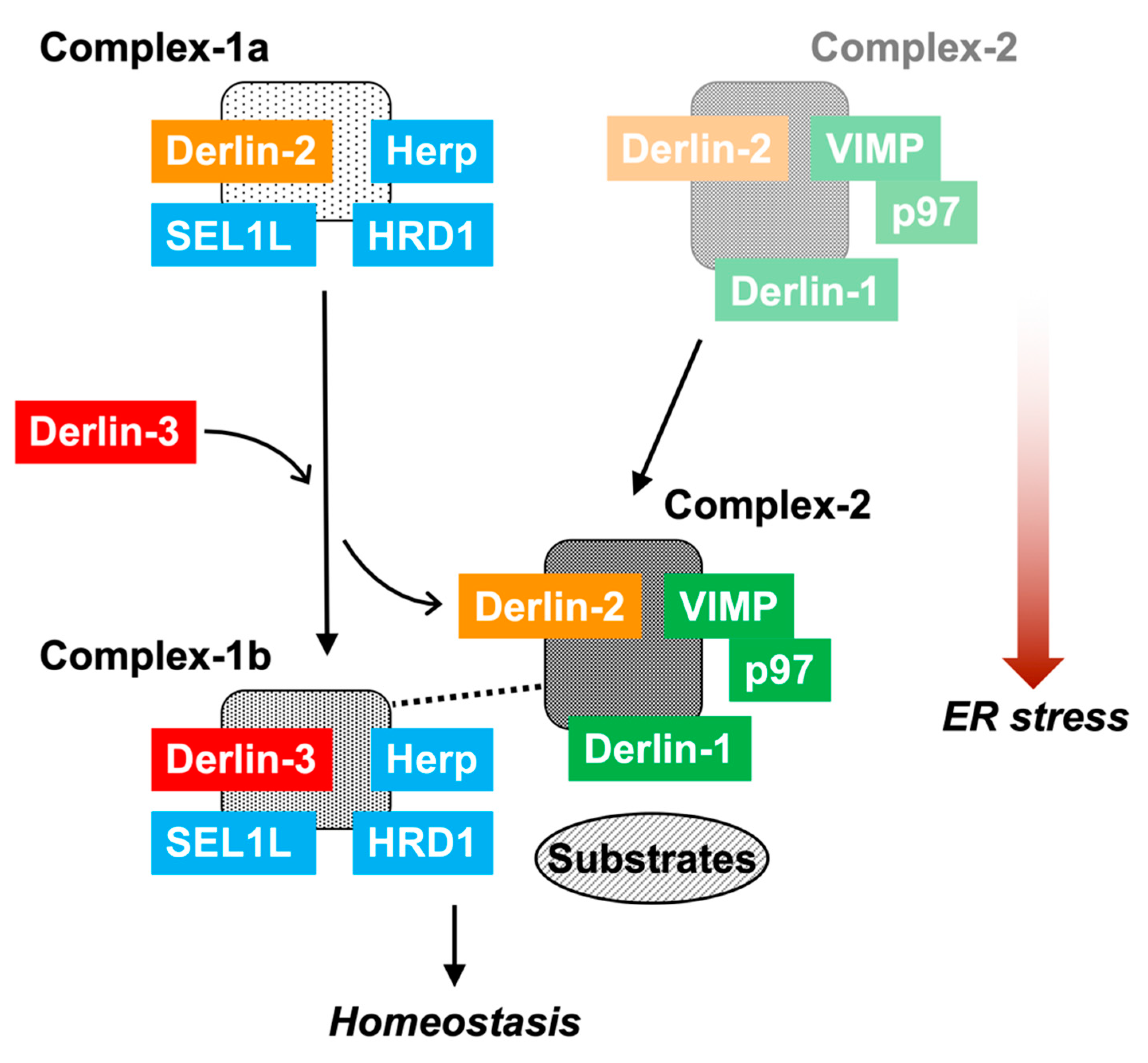Derlin-3 Is Required for Changes in ERAD Complex Formation under ER Stress
Abstract
1. Introduction
2. Results and Discussion
2.1. Expression of Herp and Derlins in Mouse Organs
2.2. Herp Is Rapidly Degraded in the Derlin-3-Deficient Pancreas
2.3. Derlin-3 Contributes to the Stability of Derlin-1 and Derlin-2 in a Herp-Dependent Manner
2.4. Herp and Derlin-3 Are Cooperatively Engaged in the Degradation of HRD1 and SEL1L
2.5. Physical Interactions among ERAD Factors—Complex-1a and Complex-1b
2.6. Physical Interactions among ERAD Factors—Complex-2
2.7. Roles of Herp and Derlin-3 on the Physical Interactions among ERAD Factors
2.8. ER Stress Changes the Distribution of ERAD Factors in Density Gradient Fractions
2.9. ERAD Complexes in the Light and Heavy Fractions
2.10. Role of Derlin-3 in the Formation of ERAD Complexes
2.11. Dynamic Nature of ERAD Complexes in Response to ER Stress
3. Materials and Methods
3.1. Ethics Statement
3.2. Western Blotting
3.3. Tissue Preparation
3.4. Subcellular Fractionation
3.5. Coimmunoprecipitation
3.6. Sucrose Density Gradient Centrifugation
Supplementary Materials
Author Contributions
Funding
Acknowledgments
Conflicts of Interest
Abbreviations
| ER | Endoplasmic reticulum |
| ERAD | ER-associated protein degradation |
| WT | Wild-type |
| 3KO | Derlin-3-deficient |
| iBAT | Interscapular brown adipose tissue |
| PBS | Phosphate-buffered saline |
| 3HKO | Derlin-3/Herp double-deficient |
| HKO | Herp-deficient |
| Tm | Tunicamycin |
| C | Control |
| IP | Immunoprecipitation |
References
- Wang, M.; Kaufman, R.J. Protein misfolding in the endoplasmic reticulum as a conduit to human disease. Nature 2016, 529, 326–335. [Google Scholar] [CrossRef] [PubMed]
- Mori, K. Signalling Pathways in the Unfolded Protein Response: Development from Yeast to Mammals. J. Biochem. 2009, 146, 743–750. [Google Scholar] [CrossRef] [PubMed]
- Walter, P.; Ron, D. The Unfolded Protein Response: From Stress Pathway to Homeostatic Regulation. Science 2011, 334, 1081–1086. [Google Scholar] [CrossRef] [PubMed]
- Hirsch, C.; Gauss, R.; Horn, S.C.; Neuber, O.; Sommer, T. The ubiquitylation machinery of the endoplasmic reticulum. Nature 2009, 458, 453–460. [Google Scholar] [CrossRef]
- Ruggiano, A.; Foresti, O.; Carvalho, P. ER-associated degradation: Protein quality control and beyond. J. Cell Boil. 2014, 204, 869–879. [Google Scholar] [CrossRef]
- Sun, Z.; Brodsky, J.L. Protein quality control in the secretory pathway. J. Cell Boil. 2019, 218, 3171–3187. [Google Scholar] [CrossRef]
- Cabral, C.M.; Liu, Y.; Sifers, R.N. Dissecting glycoprotein quality control in the secretory pathway. Trends Biochem. Sci. 2001, 26, 619–624. [Google Scholar] [CrossRef]
- Molinari, M.; Calanca, V.; Galli, C.; Lucca, P.; Paganetti, P.A. Role of EDEM in the Release of Misfolded Glycoproteins from the Calnexin Cycle. Science 2003, 299, 1397–1400. [Google Scholar] [CrossRef]
- Oda, Y. EDEM As an Acceptor of Terminally Misfolded Glycoproteins Released from Calnexin. Science 2003, 299, 1394–1397. [Google Scholar] [CrossRef]
- Ushioda, R.; Hoseki, J.; Araki, K.; Jansen, G.; Thomas, D.Y.; Nagata, K. ERdj5 is Required as a Disulfide Reductase for Degradation of Misfolded Proteins in the ER. Science 2008, 321, 569–572. [Google Scholar] [CrossRef]
- Hosokawa, N.; Kamiya, Y.; Kamiya, D.; Kato, K.; Nagata, K. Human OS-9, a Lectin Required for Glycoprotein Endoplasmic Reticulum-associated Degradation, Recognizes Mannose-trimmed N-Glycans. J. Boil. Chem. 2009, 284, 17061–17068. [Google Scholar] [CrossRef] [PubMed]
- Smith, M.H.; Ploegh, H.L.; Weissman, J.S. Road to Ruin: Targeting Proteins for Degradation in the Endoplasmic Reticulum. Science 2011, 334, 1086–1090. [Google Scholar] [CrossRef] [PubMed]
- Fang, S.; Ferrone, M.; Yang, C.; Jensen, J.P.; Tiwari, S.; Weissman, A.M. The tumor autocrine motility factor receptor, gp78, is a ubiquitin protein ligase implicated in degradation from the endoplasmic reticulum. Proc. Natl. Acad. Sci. USA 2001, 98, 14422–14427. [Google Scholar] [CrossRef] [PubMed]
- Nadav, E.; Shmueli, A.; Barr, H.; Gonen, H.; Ciechanover, A.; Reiss, Y. A novel mammalian endoplasmic reticulum ubiquitin ligase homologous to the yeast Hrd1. Biochem. Biophys. Res. Commun. 2003, 303, 91–97. [Google Scholar] [CrossRef]
- Kikkert, M. Human HRD1 Is an E3 Ubiquitin Ligase Involved in Degradation of Proteins from the Endoplasmic Reticulum. J. Boil. Chem. 2003, 279, 3525–3534. [Google Scholar] [CrossRef]
- Tanabe, K.; Lennarz, W.J.; Suzuki, T. A Cytoplasmic Peptide: N--Glycanase. Method. Enzymol. 2006, 415, 46–55. [Google Scholar] [CrossRef]
- Schulze, A.; Standera, S.; Buerger, E.; Kikkert, M.; Van Voorden, S.; Wiertz, E.; Koning, F.; Kloetzel, P.-M.; Seeger, M. The Ubiquitin-domain Protein HERP forms a Complex with Components of the Endoplasmic Reticulum Associated Degradation Pathway. J. Mol. Boil. 2005, 354, 1021–1027. [Google Scholar] [CrossRef]
- Okuda-Shimizu, Y.; Hendershot, L.M. Characterization of an ERAD Pathway for Nonglycosylated BiP Substrates, which Require Herp. Mol. Cell 2007, 28, 544–554. [Google Scholar] [CrossRef]
- Lilley, B.N.; Ploegh, H.L. Multiprotein complexes that link dislocation, ubiquitination, and extraction of misfolded proteins from the endoplasmic reticulum membrane. Proc. Natl. Acad. Sci. USA 2005, 102, 14296–14301. [Google Scholar] [CrossRef]
- Lilley, B.N.; Ploegh, H.L. A membrane protein required for dislocation of misfolded proteins from the ER. Nature 2004, 429, 834–840. [Google Scholar] [CrossRef]
- Ye, Y.; Shibata, Y.; Yun, C.; Ron, D.; Rapoport, T.A. A membrane protein complex mediates retro-translocation from the ER lumen into the cytosol. Nature 2004, 429, 841–847. [Google Scholar] [CrossRef] [PubMed]
- Wahlman, J.; DeMartino, G.N.; Skach, W.R.; Bulleid, N.J.; Brodsky, J.L.; Johnson, A.E. Real-Time Fluorescence Detection of ERAD Substrate Retrotranslocation in a Mammalian In Vitro System. Cell 2007, 129, 943–955. [Google Scholar] [CrossRef] [PubMed]
- Carvalho, P.; Stanley, A.M.; Rapoport, T.A. Retrotranslocation of a Misfolded Luminal ER Protein by the Ubiquitin-Ligase Hrd1p. Cell 2010, 143, 579–591. [Google Scholar] [CrossRef] [PubMed]
- Schoebel, S.; Mi, W.; Stein, A.; Ovchinnikov, S.; Pavlovicz, R.; DiMaio, F.; Baker, D.; Chambers, M.G.; Su, H.; Li, N.; et al. Cryo-EM structure of the protein-conducting ERAD channel Hrd1 in complex with Hrd3. Nature 2017, 548, 352–355. [Google Scholar] [CrossRef]
- Wu, X.; Siggel, M.; Ovchinnikov, S.; Mi, W.; Svetlov, V.; Nudler, E.; Liao, M.; Hummer, G.; Rapoport, T.A. Structural basis of ER-associated protein degradation mediated by the Hrd1 ubiquitin ligase complex. Science 2020, 368, 1–13. [Google Scholar]
- Vasic, V.; Denkert, N.; Schmidt, C.C.; Riedel, D.; Stein, A.; Meinecke, M. Hrd1 forms the retrotranslocation pore regulated by auto-ubiquitination and binding of misfolded proteins. Nature 2020, 22, 274–281. [Google Scholar] [CrossRef]
- Oda, Y.; Okada, T.; Yoshida, H.; Kaufman, R.J.; Nagata, K.; Mori, K. Derlin-2 and Derlin-3 are regulated by the mammalian unfolded protein response and are required for ER-associated degradation. J. Cell Boil. 2006, 172, 383–393. [Google Scholar] [CrossRef]
- Sugimoto, T.; Ninagawa, S.; Yamano, S.; Ishikawa, T.; Okada, T.; Takeda, S.; Mori, K. SEL1L-dependent substrates require Derlin2/3 and Herp1/2 for endoplasmic reticulum-associated degradation. Cell Struct. Funct. 2017, 42, 81–94. [Google Scholar] [CrossRef]
- Eura, Y.; Yanamoto, H.; Arai, Y.; Okuda, T.; Miyata, T.; Kokame, K. Derlin-1 Deficiency Is Embryonic Lethal, Derlin-3 Deficiency Appears Normal, and Herp Deficiency Is Intolerant to Glucose Load and Ischemia in Mice. PLoS ONE 2012, 7, e34298. [Google Scholar] [CrossRef]
- Belmont, P.J.; Chen, W.J.; Pedro, M.N.S.; Thuerauf, N.J.; Lowe, N.G.; Gude, N.; Hilton, B.; Wolkowicz, R.; Sussman, M.A.; Glembotski, C.C. Roles for endoplasmic reticulum-associated degradation and the novel endoplasmic reticulum stress response gene Derlin-3 in the ischemic heart. Circ. Res. 2009, 106, 307–316. [Google Scholar] [CrossRef]
- Lopez-Serra, P.; Marcilla, M.; Villanueva, A.; Ramos-Fernández, A.; Palau, A.; Leal, L.; Wahi, J.E.; Setien-Baranda, F.; Szczesna, K.; Moutinho, C.; et al. A DERL3-associated defect in the degradation of SLC2A1 mediates the Warburg effect. Nat. Commun. 2014, 5, 3608. [Google Scholar] [CrossRef] [PubMed]
- Shibata, M.; Kanda, M.; Tanaka, H.; Umeda, S.; Miwa, T.; Shimizu, D.; Hayashi, M.; Inaishi, T.; Miyajima, N.; Adachi, Y.; et al. Overexpression of Derlin 3 is associated with malignant phenotype of breast cancer cells. Oncol. Rep. 2017, 38, 1760–1766. [Google Scholar] [CrossRef] [PubMed]
- Li, Y.; Liu, H.; Chen, H.; Shao, J.; Su, F.; Zhang, S.; Cai, X.; He, X. DERL3 functions as a tumor suppressor in gastric cancer. Comput. Boil. Chem. 2020, 84, 107172. [Google Scholar] [CrossRef] [PubMed]
- Torrealba, N.; Navarro-Marquez, M.; Garrido, V.; Pedrozo, Z.; Romero, D.; Eura, Y.; Villalobos, E.; Roa, J.C.; Chiong, M.; Kokame, K.; et al. Herpud1 negatively regulates pathological cardiac hypertrophy by inducing IP3 receptor degradation. Sci. Rep. 2017, 7, 13402. [Google Scholar] [CrossRef] [PubMed]
- Navarro-Marquez, M.; Torrealba, N.; Troncoso, R.; Vásquez-Trincado, C.; Rodríguez, M.; Morales, P.E.; Villalobos, E.; Eura, Y.; García, L.; Chiong, M.; et al. Herpud1 impacts insulin-dependent glucose uptake in skeletal muscle cells by controlling the Ca2+-calcineurin-Akt axis. Biochim. Biophys. Acta (BBA)-Mol. Basis Dis. 2018, 1864, 1653–1662. [Google Scholar] [CrossRef] [PubMed]
- Kokame, K.; Agarwala, K.L.; Kato, H.; Miyata, T. Herp, a New Ubiquitin-like Membrane Protein Induced by Endoplasmic Reticulum Stress. J. Boil. Chem. 2000, 275, 32846–32853. [Google Scholar] [CrossRef]
- Kokame, K.; Kato, H.; Miyata, T. Identification of ERSE-II, a new cis-acting element responsible for the ATF6-dependent mammalian unfolded protein response. J. Biol. Chem. 2001, 276, 9199–9205. [Google Scholar] [CrossRef]
- Kny, M.; Standera, S.; Hartmann-Petersen, R.; Kloetzel, P.-M.; Seeger, M. Herp Regulates Hrd1-mediated Ubiquitylation in a Ubiquitin-like Domain-dependent Manner. J. Boil. Chem. 2010, 286, 5151–5156. [Google Scholar] [CrossRef]
- Carroll, S.M.; Hampton, R.Y. Usa1p Is Required for Optimal Function and Regulation of the Hrd1p Endoplasmic Reticulum-associated Degradation Ubiquitin Ligase. J. Boil. Chem. 2009, 285, 5146–5156. [Google Scholar] [CrossRef]
- Iida, Y.; Fujimori, T.; Okawa, K.; Nagata, K.; Wada, I.; Hosokawa, N. SEL1L Protein Critically Determines the Stability of the HRD1-SEL1L Endoplasmic Reticulum-associated Degradation (ERAD) Complex to Optimize the Degradation Kinetics of ERAD Substrates. J. Boil. Chem. 2011, 286, 16929–16939. [Google Scholar] [CrossRef]
- Carvalho, P.; Goder, V.; Rapoport, T.A. Distinct Ubiquitin-Ligase Complexes Define Convergent Pathways for the Degradation of ER Proteins. Cell 2006, 126, 361–373. [Google Scholar] [CrossRef] [PubMed]
- Crawshaw, S.G.; Cross, B.C.S.; Wilson, C.M.; High, S. The oligomeric state of Derlin-1 is modulated by endoplasmic reticulum stress. Mol. Membr. Boil. 2007, 24, 113–120. [Google Scholar] [CrossRef] [PubMed]








© 2020 by the authors. Licensee MDPI, Basel, Switzerland. This article is an open access article distributed under the terms and conditions of the Creative Commons Attribution (CC BY) license (http://creativecommons.org/licenses/by/4.0/).
Share and Cite
Eura, Y.; Miyata, T.; Kokame, K. Derlin-3 Is Required for Changes in ERAD Complex Formation under ER Stress. Int. J. Mol. Sci. 2020, 21, 6146. https://doi.org/10.3390/ijms21176146
Eura Y, Miyata T, Kokame K. Derlin-3 Is Required for Changes in ERAD Complex Formation under ER Stress. International Journal of Molecular Sciences. 2020; 21(17):6146. https://doi.org/10.3390/ijms21176146
Chicago/Turabian StyleEura, Yuka, Toshiyuki Miyata, and Koichi Kokame. 2020. "Derlin-3 Is Required for Changes in ERAD Complex Formation under ER Stress" International Journal of Molecular Sciences 21, no. 17: 6146. https://doi.org/10.3390/ijms21176146
APA StyleEura, Y., Miyata, T., & Kokame, K. (2020). Derlin-3 Is Required for Changes in ERAD Complex Formation under ER Stress. International Journal of Molecular Sciences, 21(17), 6146. https://doi.org/10.3390/ijms21176146





